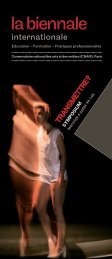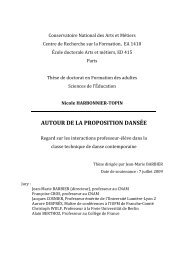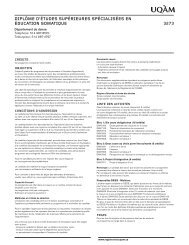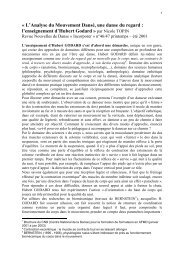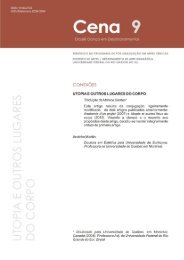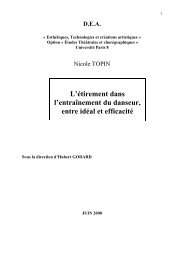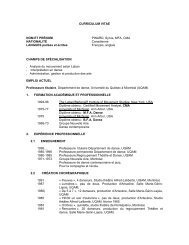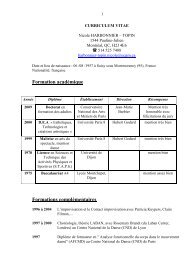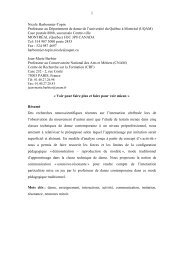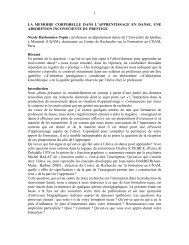Day 2 - Département de danse - UQAM
Day 2 - Département de danse - UQAM
Day 2 - Département de danse - UQAM
You also want an ePaper? Increase the reach of your titles
YUMPU automatically turns print PDFs into web optimized ePapers that Google loves.
<strong>Day</strong> 4: Tuesday, June 4<br />
9:00-10:30am<br />
Keynote: Juliana Saxton (University of Victoria)<br />
George<br />
“Plus ça Change….”<br />
Introduction: Monica Pren<strong>de</strong>rgast (University of Victoria).<br />
Sponsor: Theatre Research in Canada (Marlis Schweitzer, Editor)<br />
Juliana Saxton, professor emeritus, Department of Theatre, University of Victoria, is an international master teacher, keynote<br />
speaker and co-author of a number of texts, most recently, Applied Drama: A Facilitator’s Handbook for Working in Community<br />
(Intellect, 2013). A lifetime in theatre is context for an idiosyncratic overview of “What’s up now?”<br />
10:30am — break<br />
10:45-12:15pm<br />
a) Child’s Play: By Youth, For Youth, Like Youth George<br />
Open Panel Mo<strong>de</strong>rator: Cam Culham (University of Victoria)<br />
“Playing with signs at the edge of sense: a cognitive perspective.” Christopher Jackman<br />
(University of Toronto)<br />
In Jacques Lecoq’s scholarship on jeu (or “play”), he exploits an overlap of meanings between drama, games, and children’s<br />
play (Lecoq 191). Whether in a rehearsal room or a sandlot, play lets us alter the conditions of our experience with the world; it<br />
is the imaginative embodiment of the possibilities those novel conditions might afford. When two people are playing together,<br />
i<strong>de</strong>ntities are created, enforced, and transformed just as the rules governing those transformations are themselves hashed out<br />
through practice. It is also remarkably flexible in its incorporation of signs: a broomstick can invoke a horse as readily as two<br />
coconut halves clopping together. Child psychologist Lev Vygotsky calls play “a dynamic and complex … interactive form of<br />
social imagination” (John-Steiner et al. 11), where participants co-create its representational and behavioural “logic.” For this<br />
paper, I will <strong>de</strong>monstrate that a cognitive mo<strong>de</strong>l of play can offer a generative and rigorous account for theatrical signification:<br />
§ I will introduce the enactivist mo<strong>de</strong>l of perception, which suggests that we perceive the world in terms of the possibilities for<br />
action it affords to us, and recognizes the prece<strong>de</strong>nce of affect and intuition to conceptual knowledge. This casts both actor<br />
and spectator as embodied, active participants in the theatre event, whatever the conventional framework. § I will adopt Seitz’s<br />
theory of basic metaphor as an alternative to cognitive linguistic mo<strong>de</strong>ls of conceptual blending. Seitz’s metaphors are<br />
preconceptual linkages rooted in cross-modal perception, and facilitate real-time experiences according to “metaphorical”<br />
contingencies that aren’t themselves objects of our conscious thought. § I will <strong>de</strong>scribe play as an autonomous system of<br />
intersubjective coordination, sustained by increasing complexity in the insights it affords participants. Though I will primarily<br />
focus on physical and improvisational play, I will also indicate wi<strong>de</strong>r applications to traditional audience-actor relationships with<br />
reference to the National Theatre of Great Britain’s War Horse. This will show that a cognitive perspective of representational<br />
play foregrounds experience, intuition, and openness to possibility, whatever the conventional idiom.<br />
“Dance, Landscape and Empathetic Child Spectators.” Heather Fitzsimmons Frey (University of<br />
Toronto)<br />
Theatre for Young Audiences (TYA) is an area of theatre research that is systematically un<strong>de</strong>rstudied and marginalized by<br />
theatre scholars, even though hundreds of thousands of Canadian children see TYA annually. Dancing, performing bodies are<br />
a tool TYA practitioners often use to create on-stage worlds in or<strong>de</strong>r to both construct an imaginary landscape that the<br />
audience could not otherwise access, and to help the audience navigate the fictional space. TYA artists have often explained<br />
to me that dance allows children to experience the world of the play for the duration of the performance very effectively: some<br />
months ago I became curious as to how. Combining information from personal interviews with TYA directors and<br />
choreographers from across Canada, and a wi<strong>de</strong> range of theoretical i<strong>de</strong>as (kinesthetic empathy and mirror neurons, child and<br />
dance spectatorship, space, and ways dance can engrave culture onto a dancer’s body), this paper suggests a conceptual<br />
“theoretical tower.” Specific performances are bounced off the tower to test its stability. For the purposes of this conference, I<br />
will focus my examples on performances that address ethnic or cultural heritage. Since most Canadian schools still engage<br />
with Canada’s official multiculturalism policy, these plays are wi<strong>de</strong>ly sought out by educators. The ethnic heritage focus raises<br />
additional issues about exotification, stereotyping, and cultural reduction, which problematize the connections I make between<br />
dance, landscape, and child spectators.<br />
37



